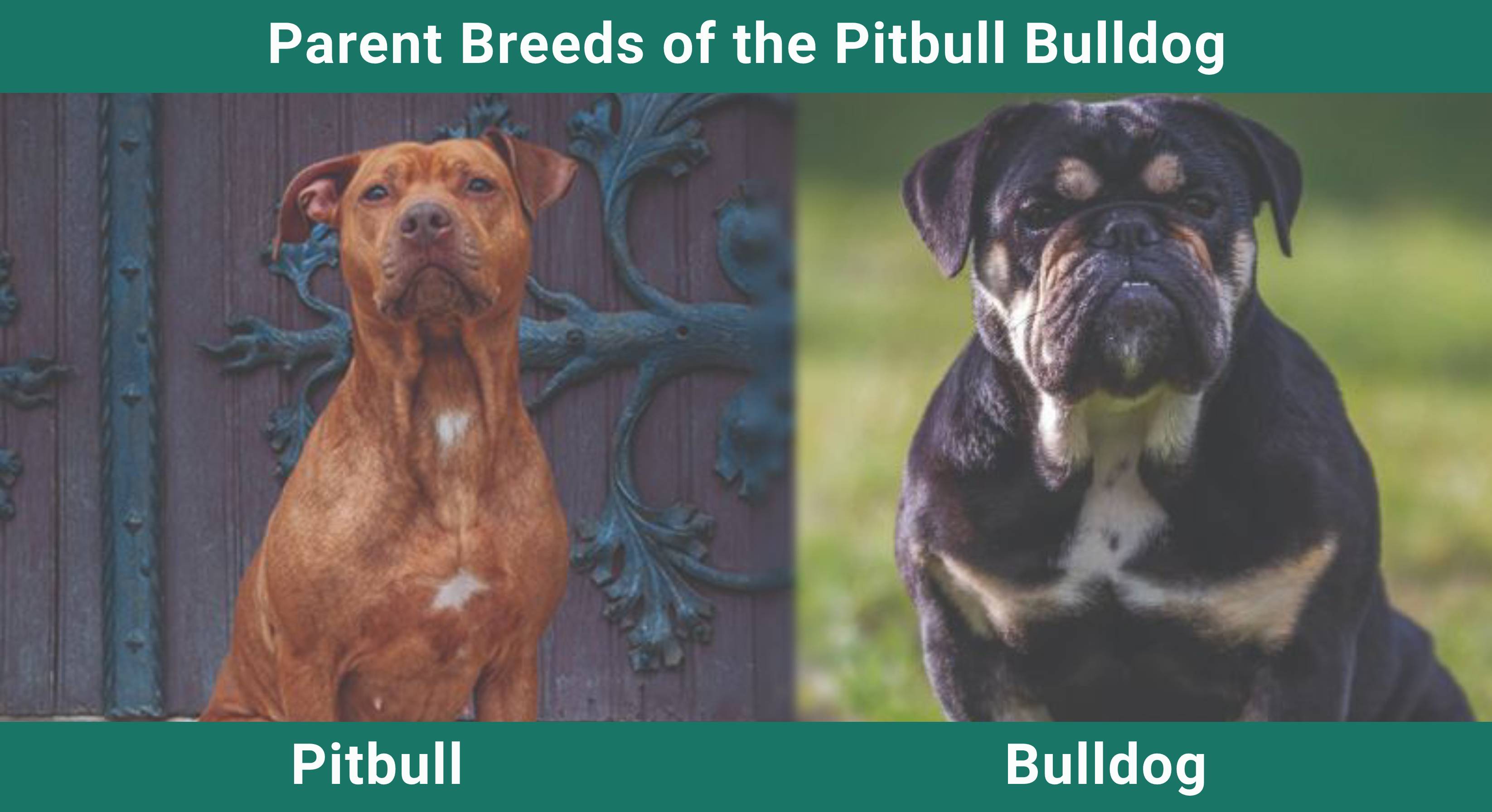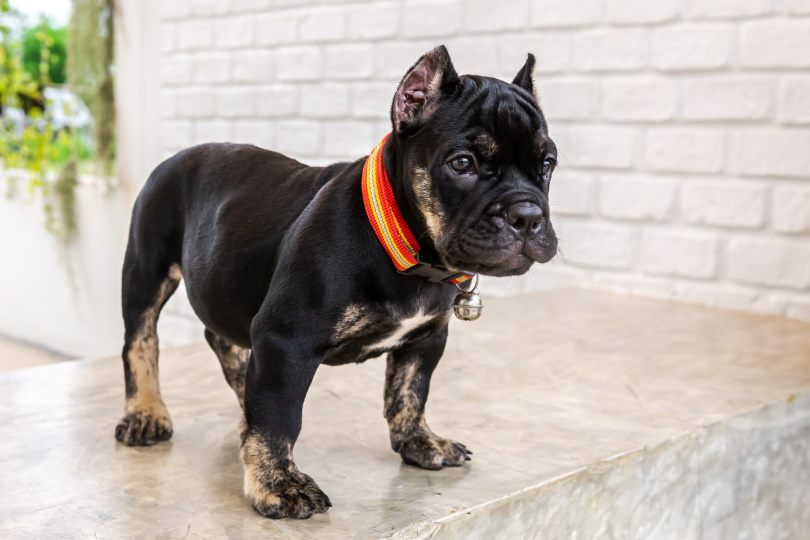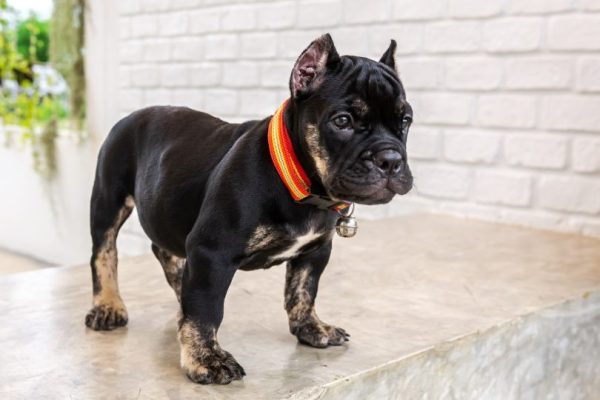Click Below to Skip Ahead
Pitbull Bulldog mixes are most often a mix between the American Pitbull Terrier and American Bulldog, though sometimes they are mixed with different types of Pitbulls and Bulldogs. These mixes can look very scary because of their bulky build and bad reputation, but they are actually kittens in disguise when trained properly.
Breed Overview
Height:
20–24 inches
Weight:
40–80 pounds
Lifespan:
10–13 years
Colors:
Brown, black, white, or mix of these colors
Suitable for:
Active families with experience training dogs
Temperament:
Loyal, overprotective, intelligent
These dogs make great pets for active families who know how to train a wild dog and are looking for a scary dog that acts like a dove. However, this dog’s more aggressive temperament means that it requires thorough socialization and training from an early age.
To learn everything that’s required for owning and training a Pitbull Bulldog mix, sometimes called a Bully Pit, keep reading.
Pitbull Bulldog Mix Puppies
Pitbull Bulldog mix puppies inherit physical traits from both parent breeds, but the exact appearance can vary depending on which breed dominates the genetic makeup. Training, socialization, and exercise are important to ensure the well-being of this breed, as with any dog.
Taking care of a Pitbull Bulldog mix requires a lot of time, patience, and effort, but can be a rewarding experience. To ensure the well-being of this breed, exercise is crucial, including daily walks, playtime and training. Training should start early and be consistent, as this breed can be stubborn and requires patience and positive reinforcement techniques. Socialization is also important, as this breed is friendly and affectionate, but early socialization can prevent behavioral issues.
Always make sure that the puppy you buy is bred only from a reputable breeder who has no intention of fighting the dogs. Not only will this ensure that the dogs in the breeder’s care are well taken care of, but it also ensures that the dog you get is healthy and not a victim of abuse, inbreeding, or a number of other unwanted scenarios

Temperament & Intelligence of the Pitbull Bulldog Mix
Both Pitbulls and Bulldogs have a reputation for being aggressive. However, Bully Pits that are properly socialized and trained aren’t going to be outright aggressive. They might not be as welcoming and inviting as a Golden Retriever, but they likely won’t scare anyone away either.
Are These Dogs Good for Families? 🏡
Bully Pits are a good breed for families if the children are slightly older. Even though well-trained Bully Pits are not very likely to attack anyone, you don’t want to run any risks. So, Bully Pits are not a good breed if you have young children in your home.
Even if your Bully Pit is well-behaved, these dogs can play a bit rough, even if they are just having fun. Once again, this can be a very dangerous situation for young children even if the Bully Pit loves the child.
As soon as your children get around the age of 10 or older, Bully Pits can make great additions to homes. Although these dogs look scary, they are incredibly affectionate and cuddly. They love having a big family that can shower them with attention.
As long as all the family members know how to behave around this dog and treat it with respect, both the family and the dog will likely feel at peace in no time.
Does This Breed Get Along With Other Pets? 🐶 😽
Unfortunately, Bully Pits are not good with other animals. Even when Bully Pits are socialized well, they likely won’t like having another animal in the home. So, it’s best to have a Bully Pit as the exclusive pet.
You might be able to get a pet that stays in a cage or a tank. For example, many Bully Pit owners have lizards or fish. However, do not get another dog or cat because the Bully Pit is likely to get very territorial over you and the home.
Things to Know When Owning a Pitbull Bulldog Mix:
Owning a Pitbull Bulldog mix can be a bit difficult if you are not used to bully breeds as a whole. Bully Pits require strict diet requirements, a lot of exercise, and medical attention. Luckily, they don’t require as much grooming as other breeds, but you need to be careful to make sure their skin doesn’t get infected.
Food & Diet Requirements 🦴
As we will learn below, Bully Pits have quite a few health issues to be aware of. One of the best ways to prevent these illnesses from being a problem is to provide the dog a correct diet. Most Bully Pits will need between 2.5 and 4 cups of high-quality dry dog food a day. The exact amount depends on your dog’s age and size.
No matter what dog food you select, make sure it is high-quality and includes a few ingredients like omega-3 fatty acids, vitamins, chondroitin, and glucosamine. These ingredients will nourish your Bully Pit’s bones and health, targeting serious conditions known to the breed.
As your dog ages, you want to select a dog food that grows with it. In other words, select a dog food designed for your dog’s stage in life, such as a senior blend for seniors and a puppy blend for newborns.
Exercise 🐕
A Bully Pit requires a lot of stimulation and exercise. Both Pitbulls and Bulldogs are active breeds. Every day, your Bully Pit should have around 90 minutes of exercise. If you do not fulfill this exercise requirement, your Bully Pit will likely become destructive out of boredom.
Luckily, Bully Pits don’t need strenuous exercise. Instead, you can opt for low-intensity walks and playing with toys inside the home. At the same time, active owners can always kick it up a bit by taking the dog on runs or playing fetch. It really depends on you since this dog is agile with some lazy streaks.
Training 🦮
Training the Bully Pit is a unique situation. Bully Pits are actually very intelligent animals that love their owners. As a result, Bully Pits quickly pick up on commands and are more than happy to follow what you’re saying to please you.
That being said, Bully Pits that do not respect their owners are less likely to listen. You must be firm and consistent with your Bully Pit to demand attention. Once your Bully Pit views you as the alpha, training is actually very easy.
It’s important to use positive reinforcement when training any dog, but especially Bully Pits. If you are aggressive to Bully Pits, they will either lash out or cower away from you. Both situations are unwanted. Instead, use treats and praise to reinforce good behavior. Your Bully Pit will respond very quickly because they love pleasing their owners.
Grooming ✂️
Bully Pits have beautiful coats that are short and shed a bit. This breed isn’t the lowest maintenance in terms of grooming, but it is far from being high maintenance. This is likely a breath of fresh air after learning all the other high-maintenance aspects of this dog.
To keep the Bully Pit’s coat healthy, you only need to use a soft brush on its coat about once or twice a week at most. You shouldn’t brush it every day or every other day because it can irritate the dog’s sensitive skin. During the shedding season, you might want to start brushing its coat more frequently just so the excess hair doesn’t get all-around your home.
Unless your Bully Pit gets into something it shouldn’t, you likely won’t need to bathe the dog. At most, you should only need a damp washcloth to wipe down the dog whenever it gets dirty during play. Never give a Bully Pit a bath more than once a month unless it gets skunked or some other similar situation.
One thing you should do frequently is to use a wet washcloth to wipe around the dog’s eye region. Bulldogs can have some serious icky eyes, and that can be passed on to Bully Pits.
Finally, make sure to brush your Bully Pit’s teeth once a day and trim claws when needed. Your Bully Pit may fight both grooming needs at first, but they cannot be ignored. Be gentle and allow your dog to smell both the clippers and toothbrush before touching their body with it.
Health and Conditions ❤️
Unfortunately, Bully Pits are not the healthiest dogs. That’s mainly because of their Bulldog parent. Bulldogs have several inheritable illnesses that Bully Pits are likely to take on. Luckily, Pitbulls are relatively healthy, causing Bully Pits to be more healthy than standard Bulldogs.
If your Bully Pit favors the Bulldog parent, you should expect it to need more medical attention than a Bully Pit that favors its Pitbull parent.
For Bully Pits that favor the Bulldog, it may have breathing issues and heart disease. You might also want to pay attention to its snout skin to make sure it is not infected. In contrast, Bully Pits that favor the Pitbull are more likely to have skin problems and allergies.
No matter which dog your Bully Pit favors, hip dysplasia can be a serious issue. Hip dysplasia is an issue for both Pitbulls and Bulldogs. So, it is highly likely for a Bully Pit to experience this in their life.
- Allergies
- Skin irritations
- Eye annoyance
- Hip dysplasia
- Heart disease
- Breathing difficulties
Male vs Female
There isn’t much difference between male and female Bully Pits. Both are relatively large dogs that are loving, and playful, but overprotective at times. Females tend to be more cautious and make better watchdogs, whereas the males make better playmates. Size-wise, they are about the same.
3 Little-Known Facts About the Pitbull Bulldog Mix
1. They are often mistaken for Pitbulls.
Something that’s funny about the Pitbull Bulldog Mix is that they are often mistaken for just being Pitbulls. When most people think of Pitbulls, they think of muscular bodies with a fat head. Although some Pitbulls follow this trait, most do not, whereas Bully Pits always do. As a result, many people see a Pitbull Bulldog Mix and assume it’s a purebred Pitbull.
You see, the classic Pitbull is a Pitbull Terrier, causing it to have a much smaller head than Bully Pits. The American Pitbull Terrier is often regarded as the true Pitbull, but it is not recognized by many organizations because of its checkered past.
2. They are super loving.
As we will learn, Bully Pits can be aggressive and overprotective over their owners, but they are also known for being some of the cuddliest and friendliest dogs when socialized and trained properly. Especially around their owners, Bully Pits act practically like kittens. They want to sit in your lap, be pet, and given all your attention.
So, many people find Bully Pits overwhelming not because they are aggressive, but because they need constant validation and attention. If you aren’t willing to have a heavy lapdog around you 24/7, a Bully Pit isn’t for you.
3. Bully Pits are some of the easiest dogs to train.
When most people see a Bully Pit, they assume that the dog is hard-headed and not well behaved. On the contrary, Bully Pits tend to be some of the easiest dogs to train. Not only are they highly intelligent, but they love to please their owners. It doesn’t take much to get a Bully Pit trained if you put in the effort.
Summary
Even though Bully Pits get a bad rap for being aggressive, these dogs are very lovable and make great additions to a home when socialized and trained properly. Of course, Bully Pits can be highly protective and aggressive if provoked, but this behavior can be squashed for the most part just from being in the right home.
It’s important to note beforehand that Bully Pits require a lot of care and attention. Not only do they demand to be by your side 24/7, but they have a lot of health conditions that can be costly to get treated. So, thoroughly investigate your own capabilities and limits before purchasing this high maintenance but lovable breed.
Related Reads:
- American Bulldog vs Pitbull: Main Differences (With Pictures)
- Pitmatian (Pitbull & Dalmatian Mix): Pictures, Guide, Info, & Care
Featured Image Credit: kong-foto, Shutterstock










